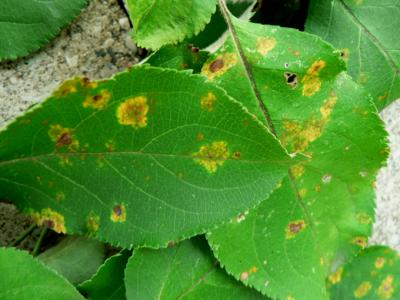Cedar Apple Rust
By Lynne Pieri-Finn, Fairfax Master Gardener Intern

Cedar apple rust fruiting bodies on cedar
One cold, wet day last year in April, I was walking my dog when, from a distance, I spotted an orange flower on a tree. Upon closer inspection, I found a dozen of these on the tree, which I presumed to be a conifer. Not flowers at all, these were gelatinous things with antlers, kind of a cross between a jelly fish and a snail. Puzzled, I went home to look this up on Google.
Cedar apple rust (Gymnosporangium junipreri – virginianae) is a fungus that affects both Eastern Red Cedar (Juniperus virginiana) and plants in the genus Malus, such as apple and crabapple. Rusts need two hosts to complete their life cycle. One is to set up and release spores, and the other to infect and cause damage. Damage is more serious on the alternate host: in this case, the apple trees.
In fall, round, woody galls will appear on twigs and small branches of the red cedar and other junipers. These galls are greenish-brown and up to 2 inches in diameter.
When conditions are right — wet and cool, above 56 degrees in April and May, the galls grow and develop orange horns. They are sometimes called “cedar apples” but apple-like they are not. Horns extend and increasing hydrostatic pressure pushes the spores out into the air.
Once the spores are released, they travel on the wind to infect apple trees. The spores arrive at about the time that apple buds are in the pink or early blossom stage. Infected apple and crabapple trees develop leaf spots, first yellow, then bright orange-red, often with a bright red border. The tree may experience leaf drop.

Rust on crabapple leaf
When the leaf spots mature, small, raised, black dots form in the upper surface of the leaves. The fruit surface develops green to brown irregular spots with black dots spots as well. The fruit spots do not extend deep into the fruit, but they are unsightly and disfiguring.
In July and August, very short (less than 1/10th inch), finger-like fungal tubes stick out from the lower surface of the leaf, directly below the leaf spots. The tubes open at the tip to release yellow orange, powdery spores.
The spores seek out Eastern Red Cedars, and the cycle begins once again. People with apple orchards must make sure there are no Eastern Red Cedar trees nearby. Spores travel widely on the wind and can infect trees many miles away. Eastern red cedars are a common conifer along roadsides, along stream banks and unkempt areas.
There are varieties of apples and crabapples that are less susceptible to the rust; however even the resistant varieties can fall to an aggressive attack. Resistant cultivars of apple include Delicious, Empire, Jonamac, McIntosh, and Paulared. Resistant crapapples are Ellwangerina, Henry Kohankie, Ormiston Roy and Red Baron. Resistant junipers are Juniperus chinensis var. sargentii, Juniperus communis ‘Aureospica’ and Juniperus virginiana ‘ Tripartita.’

Cedar apple rust gall
Fungicide sprays applied in a timely manner are effective against the cedar apple rust. Apple trees can be sprayed in early spring as a preventative measure when the galls appear on the red cedars. See the Virginia Cooperative Extension Pest Management Guide for more information on chemical and biological controls. Be sure to read the product label instructions, follow the directions for spraying and note the information regarding fungicide rotation to prevent the development of fungicide resistance.
Fungicides used on the cedar and juniper have not proved to be very effective. Pruning out the orange masses as soon as they appear is a great way to stop the cycle. Bag the galls and put them in the trash. Also, be sure to rake and trash the fallen leaves of apple and crabapple trees. The fungus can overwinter on the leaves.
Be on the lookout for these galls on red cedars and other junipers this spring. Now you’ll know when you see one that it is not an orange flower.
Resources
• Pest Management Guide: Home Grounds and Animals, 2021, Virginia Cooperative Extension,
Section 4, Home Ornamentals, 4-15
• Juniperus virginiana, North Carolina State Extension Gardener Plant Toolbox
• Eastern Red Cedar, Edward F. Gillman and Dennis G. Watson, University of Florida Extension
• Cedar-Apple Rust and Related Rust Diseases, Rebecca Koetter and Michelle Grabowski, University of
Minnesota Extension
• Ground-Ivy and Orange Growths on Cedar Trees, University of Connecticut Home and Garden
Education Center